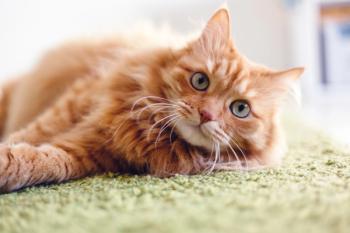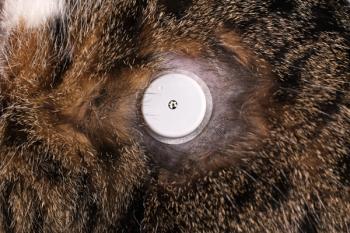
Treatment of diabetes (Proceedings)
There are many different types of insulin that vary with species of origin and with chemical modifications and formulations that affect onset and duration of action. Porcine insulin, which is identical to canine insulin in its amino acid structure, is available for use in dogs in some countries, but, unfortunately, no specific feline insulin formulation is currently available.
There are many different types of insulin that vary with species of origin and with chemical modifications and formulations that affect onset and duration of action. Porcine insulin, which is identical to canine insulin in its amino acid structure, is available for use in dogs in some countries, but, unfortunately, no specific feline insulin formulation is currently available. Human, bovine, or porcine insulins are used in treating both diabetic cats and dogs. Data concerning the pharmacokinetics and pharmacodynamics of insulin in dogs and cats are difficult to interpret. Most published studies have been conducted in normal animals, and some have been done in animals with diabetes. In either case, it is difficult to determine the effects of endogenous vs. exogenous insulin. Determinations of potency, time to peak activity and duration of activity, factors that influence choice of doses and dosing intervals, vary widely from animal to animal. In fact, there is no reasonable way to predict the kinetics of an given insulin preparation in any given patient.
Neutral protamine Hagedorn (NPH) insulin (Humulin-N®), porcine lente insulin (Vetsulin®), and protamine zinc insulin (ProZinc®, PZI) have been used commonly to treat diabetes mellitus in cats. In recent years, insulin glargine (Lantus®) has become probably the most commonly used insulin preparation in cats, despite relatively little published evidence supporting its use. Recently, another insulin analog, insulin detemir (Levemir®), has received some attention among veterinary researchers and feline practitioners.
In dogs, porcine lente insulin and NPH are used most commonly.
NPH and lente
NPH is considered an intermediate-acting insulin, and is available as a human recombinant product. NPH is used commonly in animals with diabetes, and is typically given subcutaneously twice daily. Lente insulin uses zinc as a positively charged ion on which to base insulin polymerization. Polymers are absorbed and metabolized slowly so that the onset and duration of lente insulin are extended beyond those of regular insulin. Human recombinant lente insulin has been removed from the United States market and is not longer available for use. Porcine lente insulin, however, has gained in popularity and is currently marketed and labelled for use in dogs and cats. Currently available veterinary products are Vetsulin® (U.S.) and Caninsulin®(Europe, Australia, Canada). Vetsulin, however has been largely removed from the U.S. market and is only available through special arrangement with the manufacturer. While identical to canine insulin, porcine insulin is dissimilar in amino acid sequence when compared to feline insulin, but it is no more divergent (by 3 amino acids) than is human insulin. Lente is typically given twice daily by subcutaneous injection, and studies in cats show it is a reasonable choice for treating diabetic cats.1 A recent study suggested the duration of porcine lente is shorter than either PZI or glargine in cats.
Protamine zinc insulin
PZI has been used extensively in feline diabetes. It is typically given subcutaneously twice daily, with a starting dose of 1-3 U/cat. This insulin preparation was widely available, but was largely removed from the human market in the 1990's. Recently, PZI preparations marketed for use in cats have once again become available. One veterinary PZI product, a preparation of 90% beef insulin and 10% pork insulin, was removed from the market two years ago, but a human recombinant protamine zinc insulin product approved for feline diabetics was introduced in 2009. This insulin was the subject of a multi-center clinical trial reported by Nelson et al.3 In that study of 133 diabetic cats, "good" glycemic control was defined as an average blood glucose concentration below 200 mg/dl during a 9-hour blood glucose curve. A glucose nadir of less than 150 mg/dl was also considered good, as was a serum fructosamine concentration lower than 450 μmol/L. In that study, after 45 days of twice daily treatment with PZI, 60 percent of cats exhibited good glycemic control based on the glucose nadir. Seventy-five percent of cat owners reported improved polydipsia, and 79 percent reported improved polyuria.
PZI is also available from compounding pharmacies.. Care should be taken when using PZI acquired from compounding pharmacies because of quality control issues.
Glargine and Detemir
Insulin glargine is a genetically engineered insulin analog that has hormonal action identical to native insulin, has no known immunogenicity, and achieves long-lasting glycemic control while minimizing fluctuations in blood glucose concentration in many human diabetics. Glargine is based on human recombinant insulin with a few amino acid substitutions. Glycine is substituted for an asparagine residue at the amino terminal of the A chain, and two arginine residues are added to the end of the B chain. The result is a shift in the isoelectric point of the insulin molecule so that it is completely soluble at a low pH (around pH 4). The pH of interstitial fluid is approximately 7.4, and when glargine is injected into a patient, the insulin precipitates into hexamers that are inactive. These insulin hexamers are slowly broken down in the body to form active insulin monomers. The result is that the onset is gentle and the duration is long-lived. Because of the difference in pH, glargine cannot be mixed with other insulin formulations. Experience with using glargine in cats is growing and many clinicians have had good success with its use. Glargine is best used twice daily subcutaneously.
Insulin detemir has been used in Europe for several years and was just recently approved for use in the U.S. Rather than having amino acid substitutions (like insulin glargine), insulin detemir is acylated with myristic acid, which still allows some hexamers to form at neutral pH, but, more importantly, allows the insulin to bind to albumin. This results in a very slow, smooth delivery of insulin such that once daily delivery is all that is needed in many human patients. We have done some work comparing the pharmacodynamics of glargine, detemir, and regular insulin in cats. In the cats we have studied we have found detemir to be relatively "peakless" and its duration of action is similar to that of glargine. The effect of detemir seems to be more predictable and consistent between cats, based on our studies, but this bears further investigation. The mean duration of action of insulin detemir was 13.5 hours, while glargine's mean duration of action was 11.3 hours. The difference between the two was not significant, and it was concluded that either analog might be useful as a one-a-day insulin treatment in a given cat, while others would need more frequent dosing.
Another recent study has demonstrated similar effects of glargine and detemir in cats, although the dose of detemir needed to achieve the same clinical effect was less than with glargine. One advantage of detemir might be that, because it is bound to albumin, it reaches higher concentrations in organs with fenestrated capillaries, especially the liver. This more closely mimics circulation of insulin in normal physiology. We have observed no toxic effects of detemir in cats we have studied, and it seems reasonable that detemir could be tried if adequate glycemic control is not achieved with other types of insulin.
Lispro, Aspart, and Glulisine
Historically, a combination of regular insulin and an intermediate-acting insulin was used to replace postprandial insulin in human diabetic patients. However, the action profile of regular insulin after SQ injection may be inadequate for the treatment of diabetes because its absorption is relatively slow and the duration of action is too long (about 5 – 8 hours in people, about 5 hours in cats and dogs). Insulin lispro was the first rapid-acting analog to be approved for use in people. The amino-acid sequence of insulin lispro consists of a reversal of proline at the B28 position and lysine at the B29 position. This small change greatly decreases the tendency for association and enhances the rate of absorption. In insulin aspart the proline residue at B28 is replaced with an aspartic acid residue. In insulin glulisine, lysine at B29 is replaced by glutamic acid and on position B3 asparagine is replaced by lysine. Insulin aspart and insulin glulisine have pharmacokinetic and pharmacodynamic profiles similar to insulin lispro.
There are no reports on the use of rapid-acting analogs in the chronic treatment of diabetes in cats and dogs. Insulin lispro has been successfully used in dogs to treat DKA. In that study insulin lispro was administered intravenously and had similar efficacy as the traditionally used regular insulin. No adverse reactions were seen. There is no clear rationale for preferring insulin lispro over regular insulin for use in constant-rate IV insulin infusions. The biochemical alteration in insulin lispro confers greater dissociation and faster absorption of insulin injected subcutaneously, but both insulin lispro and regular insulin should dissociate immediately when delivered intravenously.
Monitoring therapy
1. The most important aspect of monitoring a diabetic is how is the pet doing at home? The goals of therapy are to resolve the clinical signs of diabetes, prevent any consequences of diabetes and avoid inducing hypoglycemia. Therefore it is absolutely crucial to ask about water and food intake and frequency/amount of urination. Monitor the patient's weight. These details will be the most important source of information regarding how the diabetic is doing in his/her home environment.
2. Glucose curves
• The ideal glucose curve is for a minimum of 24 hours. This is obviously not feasible in some hospitals. Remember that many patients have very strong circadian rhythms. It may be necessary to make arrangements with a local emergency clinic in order to obtain evening readings.
• Blood samples should be taken every 2 hours.
• Ensure that the patients are eating as they do at home. If possible have the owners feed the pet before bringing it to the hospital.
• Stress will adversely affect the accuracy of the glucose curve, particularly in cats. Jugular catheters will minimize the stress associated with the blood draws. Ear pricks are another option. It may also be beneficial to have the patient be admitted to the hospital the day before the glucose curve to give them time to acclimate.
• For a diabetic dog without cataracts, glucose values should range between 100-250 mg/dL
• For diabetic dogs with cataracts and cats, glucose values should range between 100-300 mg/dL
• Interpretation:
o Was insulin effective in lowering BG?
o Establish highest BG
o Establish lowest BG
o Glucose differential (difference between highest and lowest reading) must be kept in mind
• If the insulin is effective, but the blood glucoses are either too high or too low: change the dose by 10-25% and recheck a curve in 1-2 weeks.
o Duration of the insulin
• Insulin that lasts for 10-12 hours should be given twice daily
• Once daily insulin should have a duration of 20-24 hours
Are blood glucose curves really useful?????
Blood glucose curves have been used extensively to monitor insulin therapy in dogs. Conventional wisdom has dictated that adjustments in insulin therapy, whether changes in dose, frequency, or type of insulin, only be made based on serial blood glucose measurements. The validity of blood glucose curves has been called into question by several recent studies.
A European group of investigators (Casella et al., J Small Anim Pract (2003) 44:298-305) studied the differences in blood glucose curves performed in-hospital vs. those performed by owners at home. Owners were instructed in blood sample collection using a simple micro-lance technique, and blood glucose concentrations were determined using portable meters. When interpreting blood glucose curves in the hospital, veterinarians commonly consider that there may be a falsely elevated degree of hyperglycemia because of the stress of hospitalization. Surprisingly, Casella and colleagues found the opposite to be true. Following repeated curves in the same dogs multiple times at home and in the hospital, it was found that mean blood glucose concentrations were significantly higher when dogs were tested at home. Recommendations for changes in insulin therapy were different 42% of the time based on the at-home vs. in-hospital curves.
Another study of blood glucose curves found more startling results. Investigators in Australia (Fleeman and Rand JAVMA (2003) 222:317-321) performed repeated blood glucose curves in dogs two weeks apart with no change in insulin therapy protocols, and compared differences between the curves. Minimum, mean, and maximum blood glucose concentrations, as well as morning and evening pre-insulin glucose concentrations, and the time to reach the nadir in blood glucose were compared. Variations in these measurements within the same dog were striking. For example, the coefficient of variation for the maximum glucose concentration was 100%, and for the time-to-nadir the CV was 98%. These results tell us that blood glucose curves may not be as helpful as we once thought. Certainly, changes in insulin regimens should be made conservatively when based on a glucose curve. Also, other methods of assessing glycemic control might be more important. Clinical signs of hyperglycemia (polyuria, polydipsia, appetite changes, weight loss, cataracts, etc.) and serum concentrations of fructosamine may be more useful indicators of glycemic control than blood glucose curves in many dogs.
How then are blood glucose curves useful? Veterinary academicians argue as to the existence of the Somogyi phenomenon, but whether some dogs experience true insulin-induced hyperglycemia (from a rebound effect in response to hypoglycemia), or whether it is a simple question of insulin kinetics, wide swings reminiscent of the Somogyi effect are possible. For example, a dog receiving insulin might respond quickly with profound hypoglycemia. If the dog experiences insulin-induced hyperglycemia or if the action of the insulin is short-lived, the dog can return quickly to a hyperglycemic state. In this instance, fructosamine would remain elevated (from persistent hyperglycemia), and clinical signs of hyperglycemia would persist. Without the information gained from a blood glucose curve, the dose of insulin might be mistakenly increased with disastrous consequences. Unfortunately, while they can only give a rough estimate of the duration of action of insulin or the appropriateness of a given dose, blood glucose curves may be the best means of identifying hypoglycemia, and they may have other uses as well.
1. Fructosamine and glycosylated hemoglobin: these are glycated proteins that are found in the blood of both normal animals and diabetics. Proteins such as albumin and hemoglobin undergo nonenzymatic, non-insulin-dependent binding of glucose. The degree to which this happens depends on the glucose concentration. Fructosamine concentrations reflect the half-life of albumin and thus serve as an index for the preceding 2-3 weeks. Glycosylated hemoglobin (GHb) is a measurement of the preceding 4-8 weeks. GHb is not as useful for our patients because it is too long of a time course to be clinically relevant. Fructosamine can also be measured at the time of the initial diagnosis to ensure that it is not purely stress causing the patient to be hyperglycemic. We typically use fructosamine as a supplement to the information gained from the glucose curve and history, not in place of those diagnostics.
2. Be careful with spot checks of blood glucose. You cannot assume when a glucose nadir (the lowest bg) will occur. This does not necessarily happen 6 or 12 hours after the patient receives insulin. Spot checks make overdosing patients far too likely.
3. Be careful adjusting insulin dose based upon glucosuria. Patients accumulate urine over hours. Their blood glucose can be 125 for 11 hours and then creep over the renal threshold for the last hour prior to receiving insulin. This patient will then test positive for urine glucose. Conversely, animals with blood glucoses of 125 will not have glucosuria. Neither will patients with blood glucoses of 25. If the owners want to monitor urine, have them keep a log of their findings to supplement other information. A patient who is repeatedly negative for glucosuria may be receiving too much insulin.
References
Martin GJ, Rand JS. Pharmacology of a 40 IU/ml porcine lente insulin preparation in diabetic cats: findings during the first week and after 5 or 9 weeks of therapy. J Feline Med Surg. 2001;(1):23-30.
Marshall RD, Rand JS, Morton JM. Glargine and protamine zinc insulin have a longer duration of action and result in lower mean daily glucose concentrations than lente insulin in healthy cats. J Vet Pharmacol Ther. 2008;31:205-12.
Nelson RW, Henley K, Cole C, et al. Field safety and efficacy of protamine zinc recombinant human insulin for treatment of diabetes mellitus in cats. J Vet Intern Med. 2009; 23:787-93.
Weaver KE, Rozanski EA, Mahony OM, et al. Use of glargine and lente insulins in cats with diabetes mellitus. J Vet Intern Med 2006;20:234-238.
Rand J. Editorial: glargine, a new long-acting insulin analog for diabetic cats. J Vet Intern Med 2006;20:219-220.
Gilor C, Ridge TK, Attermeier KJ, Graves TK. Pharmacodynamics of insulin detemir and insulin glargine assessed by an isoglycemic clamp method in healthy cats. J Vet Intern Med 2010; 24:870-874.
Roomp K, Rand J. Intensive blood glucose control is safe and effective in diabetic cats using home monitoring and treatment with glargine. J Feline Med Surg. 2009;11:668-82.
Rave K, Potocka E, Boss AH, et al. Pharmacokinetics and linear exposure of AFRESA compared with the subcutaneous injection of regular human insulin. Diabetes Obes Metab 2009;11:715-720.
Plum A, Agerso H, Andersen L. Pharmacokinetics of the rapid-acting insulin analog, insulin aspart, in rats, dogs, and pigs, and pharmacodynamics of insulin aspart in pigs. Drug Metab Dispos 2000;28:155-160.
Sheldon B, Russell-Jones D, Wright J. Insulin analogues: an example of applied medical science. Diabetes Obes Metab 2009;11:5-19.
Sears KW, Drobatz KJ, Hess RW. Use of lispro insulin for treatment of dogs with diabetic ketoacidosis (abtract #40). J Vet Intern Med 2009;23:696
Newsletter
From exam room tips to practice management insights, get trusted veterinary news delivered straight to your inbox—subscribe to dvm360.




